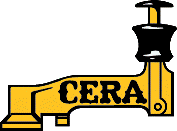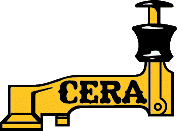|

About the CERA Logo
by CERA member Roy G. Benedict
The CERA logo, designed by CERA member Thomas A. Carpenter, depicts the handle of an electric interurban multiple unit car controller incorporating a “dead-man” button. So what is that? This essay explains how the controller handle is the symbol of the train motorman's profession.
The controller of an electric railway vehicle is the equivalent of the gas pedal of an auto. Each of them is the instrument by which the person operating the vehicle calls for power to maintain speed or accelerate. Traditional electric railway car controllers were the state of the technological art from the 1890s to the 1930s.
The controller was operated by the motorman with his left hand. He set the crank-shaped controller handle in any of several positions or points. One position, calling for no power, caused the car to coast. Each of the other points applied power to the traction motors that propelled the car.
The different points on the controller connected the motors in different series or parallel connections with or without resistance. The effect was to apply a successfully higher voltage to each motor as the motorman notched up the controller. The higher the motor voltage, the faster the rotation of the motor armature and thus the higher the speed of the vehicle.
The controller handle was mounted on a vertical shaft extending down through the controller case. Attached to the shaft or cylinder, and rotating with it, were a dozen or so segments, copper strips each extending part way around the shaft. With the controller at various points, each segment either did or did not make electrical contact with a spring-mounted finger which in turn was hard-wired to trolley voltage, to groups of resistance, or to ground. When two segments not insulated from one another both were in contact with their respective fingers, the proper circuit connection for that point of the controller was thus completed.
Backing the vehicle was achieved with the reverser key, a short handle that turned a smaller second cylinder governing connections to the motor armatures and fields to control the direction of the motors. This cylinder had three positions--forward, off, and reverse--with mechanical interlocks to ensure that it could be moved only with the controller handle in the “coast” position. Further, the controller handle could not be turned to call for power while the reverse cylinder was in “off” position. Finally, the reverser key could be removed only in the “off” position, thus effectively locking the controller.
Platform control used the motorman's controller to make and break circuits at full trolley voltage, often 600 volts direct current. With more powerful cars, in electric locomotives, or for the operation of multi-car trains, it was undesirable to break the resulting higher currents right “under the motorman's hand.” For these applications multiple unit control (sometimes called remote control) was used. The first MU control was developed in 1897 for the Chicago elevated. MU control used low currents (and sometimes low voltages) in the controller to operate servo devices which in turn handled the traction current. The high-current circuits thus were opened and closed below the car body or below each car of a multiple unit train. The motorman's controller became a master controller commanding, but not itself performing, the events which it governed.
The servo devices were of two types, each favored by a different equipment maker. One type utilized electro-magnetically operated contactors and reversers which opened and closed the traction circuits. The other type accomplished the same thing with unit switches which were powered by compressed air admitted through magnet valves.
The motorman's job may have been classed as semi-skilled labor, but traditionally it was left to his judgment when to move to each successive point in accelerating his car. Notching up too rapidly abused the motors. However, running too long on resistance points wasted electricity and overheated the resistors. Operation for sustained periods ideally involved some combination of coasting and the use of the full series and full parallel points, which had no resistance in the circuit. This was difficult to achieve in city streetcar operation with frequent stops and heavy street traffic. Fortunately, a reasonable compromise of the demands on the motorman could be learned.
With MU control, the task could be partially automated with automatic acceleration. These control systems measured the motor current and then determined for themselves how soon to advance to the next point.
So much for powering the car: What about braking it to a stop? Either entirely mechanical hand brakes (on smaller, older cars) or air brakes were entirely separate from propulsion control and were the province of the motorman's right hand. A minority of electric railway cars were provided with electrically actuated brakes, which could be integrated into a controller.
A controller handle could be supplied with spring-loaded button on top, or other means, which required continuous pressure of the motorman's hand while the power was to be applied. The same thing could be accomplished with a foot pedal. In diesel locomotives for railroads, the principle is sometimes called “dead-man control."
Developed in the 1910s for one-man operation of streetcars or light interurban cars was safety car control which interlocked the application of power, release of brakes and even door control.
Another variation, again in a minority, was the use of controllers of several different forms other than with a vertical shaft as already described. Beginning in the 1920's there was a trend toward operation of controls with foot pedals instead of by hand. The result could be motorman's controls similar in appearance to the gas and brake pedals of an automobile even though very different in the technology which they controlled. Because of the demands of on-vehicle fare collection, “hands free” control was desirable even though there is, of course, no need to steer a rail vehicle.
